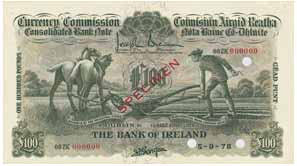
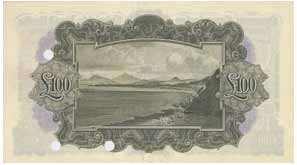
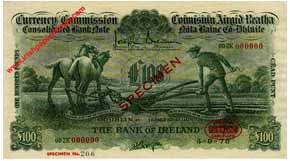
The Central Bank of Ireland Archive, which was opened to public access in 2017, has provided new source material on the Consolidated Bank Notes, the 'Ploughman' series. This is referenced as CBIAR in the text.
The Ploughman Scan Survey is a detailed recording of the numbers and grades of the surviving Ploughman Pound notes which has been underway for over 15 years which has lead to a solid data set of 3,902 notes recorded, of which 2,639 are £1 notes.
Information on the numbers of surviving Ploughman One Pound notes is updated periodically in the Ploughman Note Population Report.
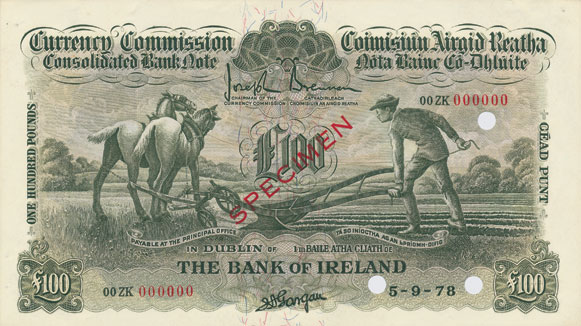
![]()
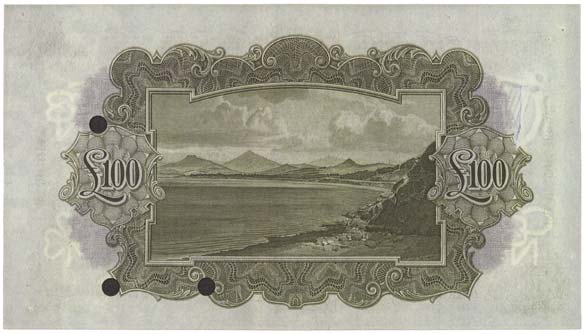
The banknotes were designed by artist Dermod O'Brien (1865-1945) [2.].
The 100 Pound Consolidated Bank Note is primarily olive green in colour.
The shade of green is similar to that of the 'Lady Lavery' series 100 Pound Legal Tender Notes which were first issued in 1928, shortly before the Consolidated note issue in 1929. This is very much in-line with other denominations of the Consolidated Bank Notes which closely matched their Legal Tender Note counterparts.
All the text on the Consolidated Bank Notes of the note is bilingual. The notes were printed in English on the left side and in Irish on the right.
The issuing authority title is in large letteing along the top: 'Currency Commission Consolidated Bank Note', 'Coimisiún Airgid Reatha Nóta Bainc Có-Dhlúite'.
The main signature, Joseph Brennan [3.], is printed at the top in the centre of each note, with his title below it in much smaller letters, 'Chairman of the Currency Commission', 'Cathaoirleach Choimisiúin an Airgid Reatha'.
The denomination in words is printed discretely sideways on either side, 'One Hundred Pounds' on the left, 'Céad Punt' on the right.
Near the bottom of each note is printed in smaller text: 'Payable at the Principle Office in Dublin of', 'Tá so iníoctha ag an bPríomh-Oifig i mBaile Átha Cliath de'.
The name of one of the eight note issuing Associated Banks was printed below the 'payable at' text in a separate printing along with the date and prefix of each banknote. Directly below the bank title the bank signatory was also added along with the date and prefix details.
There are three types of specimens for the Consolidated Bank Notes which provide an opportunity to collectors to obtain examples of the £20, £50, and £100 notes. Official specimens of the issued note designs in the standard colours produced by the Currency Commission in 1929 tend to be the most expensive. Although produced in large quantities, few sets are in private hands and they are seldom offered.
Colour trials were printed in a variety of colours without the names of the associated banks or dates and serial numbers. Examples of these colour trials are rare and seldom offered.
Also available to collectors as examples of the higher denomination Ploughman £20, £50, and £100 notes are De La Rue specimens which were printed in non-standard colours on unwatermarked paper. These notes tend to turn up glued into printer's specimen books, or loose with a glue stain after being removed from such a book.
Although mainly green, the De La Rue 100 Pound Ploughman specimen note is a darker green than the olive green of the standard issue 100 note. Minor varieties have been recorded of the De La Rue Ploughman specimens.
These De La Rue Ploughman printer's specimens tend to be described as colour trials, which they may well be, though they could also have been printed after the issue of Ploughman notes as samples of teh company's work. They are the least rare of the specimen notes and there have been a setady stream of offerings over the past twenty years, with the £100 note being the least commonly offered denomination.
With no examples of issued notes available, when an example of a Ploughman 100 Pound specimen of any type is offered, it tends to fetch a high price.
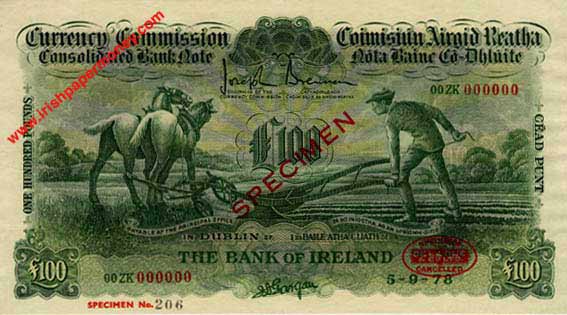
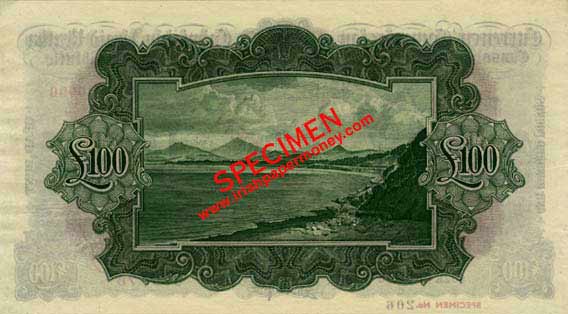

Below, a Ploughman 100 Pound note proof or trial in blue, with an example of the dark green De La Rue printer's specimen above
The reverse of the Ploughman One Hundred Pound note is printed in green ink, and features a broad view of Killiney Bay in south County Dublin.

Killiney Bay, Dublin in 2007. [4. Image copyright William Murphy. Image source: https://commons.wikimedia.org/wiki/File:KILLINEY-147_%281424762996%29.jpg]
Each denomination of the Consolidated Bank Notes were the same size as their corresponding Legal Tender Note denomination. The Ploughman 100 Pound note dimensions are 203 x 114 mm, the same as those of the £20 and £50 notes. This can vary by a millimetre or so depending on the accuracy of the cutting down process.
Below is illustrated an example of the first date of a Ploughman 100 Pound note, issued by the Munster and Leinster Bank. 6 May 1929 was the only date to be printed for the Ploughman 100 Pound notes, apart from a later print run ordered for the Bank of Ireland which had a second date, 3 November 1930 [CBIAR].

The Ploughman one pound notes were printed in several passes. Initially, a multicolored underprint was printed. This was followed by the top printing layer in dark green ink of raised intaglio printing which at the time would have been difficult for forgers to reproduce effectively.
The title of the Issuing Authority on the top of the banknote, 'Currency Commission Consolidated Bank Note', 'Coimisiún Airgid Reatha Nóta Bainc Có-Dhlúite' and the signature 'Joseph Brennan' are printed in raised intaglio print. Intaglio printing was a difficult feature for forgers to reproduce effectively.
In addition to the intaglio printing, the Ploughman 100 notes had a strip of multicolored fibers which were embedded in the paper running down the centre of each note.
This security feature which was also used on banknotes of some other countries in the 1920s and 1930s. The Watermarks and fibre strip are visible in the Portals sample paper, pictured below.
Thomas De La Rue Limited in London printed the Ploughman Hundred Pound notes on watermarked paper which was manufactured by Portals Limited.
There are four watermarks on the Consolidated One Hundred Pound note, one in each of the four corners.
When viewed from the face of the note, the four watermarks on the Ploughman 100 Pound note are as follows: a harp on the left, the letters 'CBN' (standing for Consolidated Bank Note) on the right, the letters 'CBN' on the bottom left, and a shamrock on the bottom right. The £50 note watermarks are common to the £20, £50, and £100 denominations.
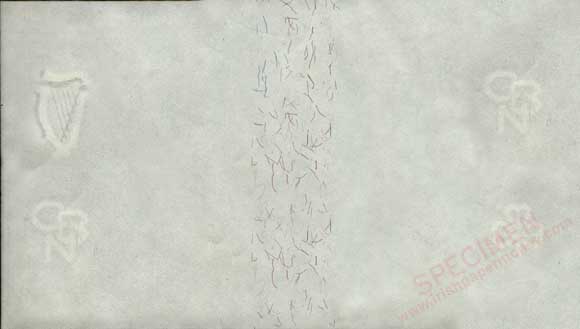
A mock-up of the watermarks and coloured security fibres on the Ploughman £20, £50, and £100 notes illustrates the four watermarks as they appear on the Ploughman One Hundred Pound note when it is viewed from the face side

When a Ploughman 100 Pound note is held up to the light and viewed from the reverse side, the four watermarks are clearly visible
£1, £5, and £10 Consolidated Bank Notes circulated in modest quantities in Ireland during the lifetime of the issue alongside the 'Lady Lavery' Legal Tender Notes. Consolidated notes continued to be accepted in occasional circulation right up to the 1960s, and were still being paid into banks in significant quantities as decimalisation approached in 1971.
While all eight Associated Banks made significant usage of the lower three denominations of Consolidated Bank Notes, the issue of higher denominations was less, with that of £50 and £100 notes being very low.
It is known from Currency Commission records that the £100 denomination had a very low circulation, mostly in the 1930s. The total issue of £100 notes was very small. As with the £50, only four of the banks opted to issue the Consolidated £100 notes. Two of these banks, the Munster and Leinster Bank and the Royal Bank of Ireland were new to note issue, having not been permitted to issue notes prior to the Currency Commission era.
Below are listed by bank the quantities of Ploughman £100 notes which are known to have been printed. This is based on Central Bank records [CBIAR].
Bank of Ireland: 6.5.29, BZ 000001 – 01BZ 000100; 3.11.30, 01BZ 000101 – 01BZ 000150.
Munster and Leinster Bank: 6.5.29, 01MZ 000001 – 01MZ 000050.
Royal Bank of Ireland: 6.5.29, 01RZ 000001 – 01RZ 000020.
Ulster Bank: 6.5.29, 01UZ 000001 – 01UZ 000050.
Consolidated Bank Notes ceased production after the Currency Commission Ireland was wound up and replaced by the Central Bank of Ireland.
Central Bank of Ireland records indicate that there was only one print run of Ploughman 100 Pound notes. Partly printed notes were stored for later use, and some of these later had the date 3.11.30 added for issue by the Bank of Ireland [CBIAR].
Much of the printage of £100 notes appears to have been destroyed without having been issued [CBIAR].
On 31 December 1953 all issues of Consolidated notes ceased, with the Central Bank of Ireland becoming the sole issuer of banknotes in Ireland.
All issued Consolidated £100 notes have been redeemed. However, several varieties of Ploughman 100 Pound specimen notes are known. However, they are generally rare and are seldom offered.
All the known examples of Ploughman 100 Pound specimen notes are recorded in the Consolidated Bank Note Population Report from the Ploughman Scan Survey.
There were four signature varieties for the Ploughman £100 note, one for each of the four banks which issued the denomination. Only examples of the Munster and Leinster Bank are known to have survived, and are signed by Gubbins. A small number of the notes are in the Central Bank archives. Examples of Bank of Ireland Ploughman £100 notes have survuved as specimens, with Gargan signature.
Bank of Ireland: Gargan 1929, 1930.
Hibernian Bank: .
Munster & Leinster Bank: Gubbins 1929.
National Bank: .
Northern Bank: .
Provincial Bank of Ireland: .
Royal Bank of Ireland: Stanley 1929.
Ulster Bank: Patton 1929.
References [Last retrieved 14.08.24]
1. Central Bank of Ireland Archives.
2. Dermod O'Brien (1865-1945) <https://www.dib.ie/biography/obrien-dermod-a6460p>
3. Joseph Brennan (1887-1976) <https://www.dib.ie/biography/brennan-joseph-a0938>
4. Killiney Bay, Dublin in 2007. Image copyright William Murphy. Image source: https://commons.wikimedia.org/wiki/File:KILLINEY-147_%281424762996%29.jpg], reproduced under the Creative Commons Attribution-Share Alike 2.0 Generic license..
1 Pound Ploughman
5 Pounds Ploughman
10 Pounds Ploughman
20 Pounds Ploughman
50 Pounds Ploughman
100 Pounds Ploughman
Irish Ten Shilling Notes
1 Pound Note Lady Lavery
5 Pounds Lady Lavery
10 Pounds Lady Lavery
20 Pounds Lady Lavery
50 Pounds Lady Lavery
100 Pounds Lady Lavery
1 Pound Note, Queen Medb
5 Pound Note, John Scotus Eriugena
10 Pound Note, Jonathan Swift
20 Pound Note, W. B. Yeats
50 Pound Note, Turlough O'Carolan
100 Pound Note, Grace O'Malley
5 Pound Note, Sister Catherine McAuley
10 Pound Note, James Joyce
20 Pound Note, Daniel O'Connell
50 Pound Note, Douglas Hyde
100 Pound Note, Charles Stewart Parnell
Special Sections and Articles
The Transition of Irish Currency, Irish banknotes 1918–1928
The Partition of Irish Currency, Irish banknotes 1928–1930
Banknote Design Evolution 1824 to 1916
Irish Three Pound Notes
Contemporary Forgeries of Early Irish Banknotes, ca1800-1930
Limerick Soviet Notes
Irish World War 2 Banknote Issues
Low Number Irish Banknotes
Irish Joint Stock Banks of Note Issue from 1783
Irish Legal Tender Note Specimens
Ploughman Scan Survey (PSS)
![]() Stable version. Last update 24.08.24. Revision with additions pending.
Stable version. Last update 24.08.24. Revision with additions pending.